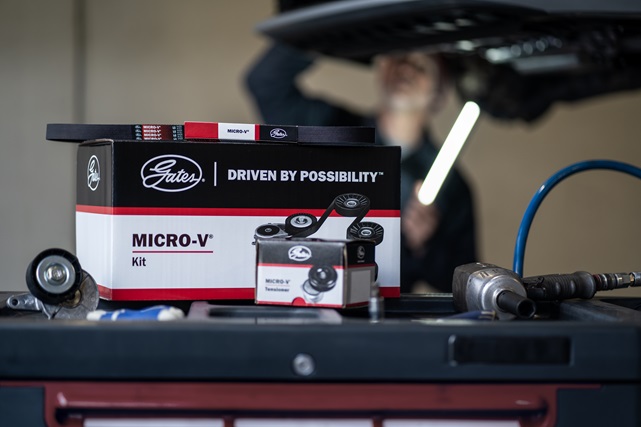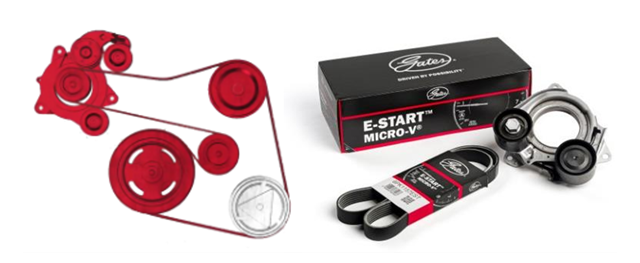In the complex world of automotive engineering, accessory belt drive systems (ABDS) play key, but often underrated roles in overall engine performance. As engines have become more compact and more efficient, the demands on ABDS systems have increased to such a degree that regular maintenance is an essential part of vehicle reliability. This introduction explores the evolution of the ABDS and highlights the importance of holistic maintenance — changing belts, tensioners, and pulleys together — as preventive measures that maintain engine reliability, ensure peak vehicle performance and help to eliminate the need for remedial repairs at the repairer’s expense.

-
PREVENTIVE MAINTENENCE AND GOOD WORKSHOP PRACTICE
As the engine accumulates hours of operation, the individual ABDS components begin to exhibit wear and consequently, the efficiency of the drive system is reduced. The performance of some parts may deteriorate more quickly than others. This deterioration, in turn, adversely affects the entire ABDS, which is now working much harder, but less efficiently.
The vehicle will soon be returning to the workshop for repairs.
Strategies that advocate corrective maintenance only when parts fail, offer false economies. It’s more sensible - and good working practice - to anticipate potential component failures by introducing preventive maintenance programs. These are designed to preserve ABDS performance, avoid drive system failure and ensure that engine performance is never compromised.
Let's review the function of each component of the ABDS and why it is necessary to maintain it.

The main component of the system, the Micro-V belt, receives power from the crankshaft and uses it to drive systems such as power steering and air conditioning, as well as water pumps (if fitted into the system). It often receives greater attention during a maintenance procedure because of its relatively low cost. A noisy belt or a lack of traction is usually an early indication that some other element of the system is not operating correctly.
If changing a tensioner that still seems to be working well seems odd to vehicle users, remind them about its vital functions:
- Keeping the correct tension in the ABDS. The tensioner must be able to adapt the tension in the drive according to certain factors such as:
- Engine temperature - as the temperature rises, the engine expands and increases belt tension
- Tolerances and wear - the ABDS is a dynamic system, where tolerances exist and must be compensated for by this component. In addition, wear can cause the system tension to drop and the tensioner is designed to make adjustments
- Dynamic system load - engine performance, A/C compressor or alternator load are the main dynamic forces acting on the system
- Vibration damping. This is produced by friction between the shaft bushing and the pivot
- Maintain correct alignment. If the tensioner loses its correct positioning in the belt plane, belt temperature and wear will increase rapidly
Perhaps the simplest ABDS component of all, Its function is to redirect the belt to the next accessory or simply to avoid vibration in long paths. It is not exempt from wear, which can cause the belt to lose alignment. This creates noise, overheating and additional wear on the belt.
These are components that can be driven either by a timing belt or an accessory belt. A common error is to assume that if fitted to an ABDS, the water pump should be changed only if it starts to fail. However, replacement at the time of a belt change provides an opportunity to clean the coolant circuit, prevent subsequent failure and avoid expensive remedial repairs when the vehicle is returned to the workshop.
- 5. Alternator decoupler pulley
Although now back to being a solid pulley on vehicles using a reversible alternator, the alternator pulley is a pulley with a mechanism that allows the alternator shaft to be decoupled from the ABDS. This occurs when the rotational speed of the system is less than that of the alternator. This action also allows the engine to run smoother at idle speed.
With a constant workload, the mechanism can become ‘blocked’, causing the pulley to behave like a solid pulley. This creates even more work for the rest of the components. A consequence is a deterioration in performance and premature wear of the belt.
- 6. Crankshaft pulley or Torsional Vibration Damper (TVD)
The crankshaft shaft transmits the power, which drives the rest of the accessories in the ABDS. As a consequence of the power of transmission, the vibrations that the engine produces are also transmitted. TVD pulleys incorporate a band of rubber that dampens these vibrations. Over time, the rubber deteriorates, causing a greater amount of vibration, a large misalignment - or both.

In contrast to a standard accessory belt, E-Start systems usually have a dual tensioner concept, it means that the system will have two tensioners, one on each side of the alternator pulley, in this way the alternator pulley is correctly wrapped by the Micro-V belt and ensure the right grip. The tension and stress driven by these systems is far higher. Consequently, wear to both the belt and the tensioner is also higher and that is why the maintenance intervals are usually earlier than mechanics have been used to. The approximate intervals are between 90.000 - 140.000 km.
Watch out for an exclusive article to further explain the working principles of these systems quite soon.
Many vehicles are equipped with a system that, having an stretch fit belt to operate, does not have a tensioner, but this does not mean that the rest of the components do not deteriorate, the alternator pulley and the crankshaft pulley still have to work and end up deteriorating in the same way, so, even if the car does not have a tensioner, the correct maintenance involves changing components that are close to the end of their useful life..
CONCLUSION:
The problems in an ABDS are not always a consequence of the individual failure of isolated components. Sometimes, they occur because of small amounts of wear on all of the components. In conclusion, what’s clear is that the complexity and compact design of modern engines requires a shift in the vehicle maintenance perspective. The ABDS is integral to vehicle performance. It demands thorough and proactive care.
By introducing a preventive maintenance approach — replacing all components together, rather than individually — not only do we enhance vehicle reliability, but we also achieve significant cost savings by minimizing future repairs. This holistic approach is not just about maintaining a vehicle. It’s also about ensuring its optimal performance and reliability over the long haul.
ADDITIONAL RESSOURCES:
Discover why the Micro-V® Kit is the only choice for an efficient and safe overhaul of the Accessory Belt Drive System by watching the video: https://youtu.be/xWrbhPe-0E4
One Name, One Box, One Solution landing page: https://visit.gates.com/gb-en-KitConversion.html
Gates® E-Start™ Micro-V® kits for Hybrid Solution: https://www.gatestechzone.com/en/product-info/passenger-cars-and-light-commercial-vehicles/hybrid-solutions
Download your guide to Accessory Belt Drive System inspection, accurately diagnosing accessory belt drive problems, useful troubleshooting tips, and instructions for fitting replacement parts: https://visit.gates.com/gb-en-KitConversion.html#